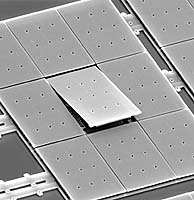| . |  |
. |
 Lockheed Proposes Design Study For Planet Searching Space Scope
Lockheed Proposes Design Study For Planet Searching Space ScopeSunnyvale - February 4, 2000 - A team led by Lockheed Martin Space Systems has proposed to JPL that it study several design options for NASA's Terrestrial Planet Finder (TPF) mission. TPF, a key mission in NASA's Origins Program, is targeted for launch in 2011 and will seek to identify Earth-like planets around nearby stars. "We're extremely proud as a company to be competing for this very important mission," said Domenick Tenerelli, Space Systems program manager for TPF. "A search for planets like our own addresses directly the fundamental question of origins and the search for a unified theory of life, and we're delighted to be able to propose to JPL ways to accomplish that mission." The Lockheed Martin team, which includes the University of Arizona and the Massachusetts Institute of Technology, is well suited to the technological challenges posed by the TPF mission. Space Systems built and integrated the Hubble Space Telescope (HST) at its Sunnyvale facility, and HST's ultra-quiet systems have direct application to TPF. NASA's Space Infrared Telescope Facility (SIRTF) spacecraft is currently under construction at Space Systems. The SIRTF Pointing and Control Reference System will operate at a temperature of 1.4 Kelvin, slightly cooler than the threshold required for TPF. Additionally, with JPL, Space Systems is designing and building the interferometer for NASA's Space Interferometry Mission. Team member Dr. Roger Angel of the University of Arizona, a MacArthur Fellowship award recipient, is pioneering the development of lightweight mirror systems (less than 15kg/m2) and optical designs consistent with the requirements of TPF. Team member Dr. David Miller of MIT has done groundbreaking research into the process of flying multiple spacecraft in formation that will be required for programs like TPF. The Terrestrial Planet Finder (TPF) will study all aspects of planets, from their formation and development in disks of dust and gas around newly forming stars, to the presence and features of those planets orbiting the nearest stars. It will investigate the numbers of planets at various sizes and places in their solar systems, and gauge their potential suitability as abodes for life. By combining the high sensitivity of space telescopes with the sharply detailed pictures from an interferometer, TPF will be able to reduce the glare of parent stars by a factor of more than 100,000 to see planetary systems as far away as 50 light years. TPF's spectroscopy will enable the measurement of size, temperature, and placement of planets as small as the Earth in the habitable zones of distant solar systems. This will allow atmospheric chemists and biologists to calculate relative amounts of gasses like carbon dioxide, water vapor, ozone and methane in planetary atmospheres and determine whether a planet might now or someday support life. In addition to studying planets around nearby mature stars like the sun, TPF will advance an understanding of how planets and their parent stars form. The disks of forming stars are a few earth-to-sun units (AU) across. TPF will study such structures on the scale of a few tenths of an AU to investigate how gaseous (Jupiter-like) and rocky (Earth-like) planets form out of disk material. By studying the heat glow from dust, ice and gasses such as hydrogen and carbon monoxide, TPF will investigate whether, as theory predicts, rocky planets form in warmer regions and gaseous planets in colder regions while a solar system is being born. TPF will also be able to examine many other astronomical objects where high resolution pictures, 100 times more detailed than those from Hubble, are critical to understanding astrophysical processes. Combining the sensitivity of the Next Generation Space Telescope (NGST) with detailed imaging will allow TPF to study the winds from dying stars that enrich the interstellar medium with life-enabling heavy atoms (like carbon and nitrogen). TPF will also enable astronomers to view the cores of quasars, and even the black hole at the center of our Milky Way galaxy.
SPACE SCOPES
Caption A micromirror developed by Sandia engineer Ernie Garcia is pictured in the tilted position. Each mirror has a diameter slightly larger than a human hair.
SpaceScope News at SpaceDaily
|
| |||||||||
| The content herein, unless otherwise known to be public domain, are Copyright 1995-2016 - Space Media Network. All websites are published in Australia and are solely subject to Australian law and governed by Fair Use principals for news reporting and research purposes. AFP, UPI and IANS news wire stories are copyright Agence France-Presse, United Press International and Indo-Asia News Service. ESA news reports are copyright European Space Agency. All NASA sourced material is public domain. Additional copyrights may apply in whole or part to other bona fide parties. Advertising does not imply endorsement, agreement or approval of any opinions, statements or information provided by Space Media Network on any Web page published or hosted by Space Media Network. Privacy Statement All images and articles appearing on Space Media Network have been edited or digitally altered in some way. Any requests to remove copyright material will be acted upon in a timely and appropriate manner. Any attempt to extort money from Space Media Network will be ignored and reported to Australian Law Enforcement Agencies as a potential case of financial fraud involving the use of a telephonic carriage device or postal service. |